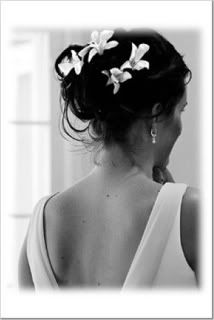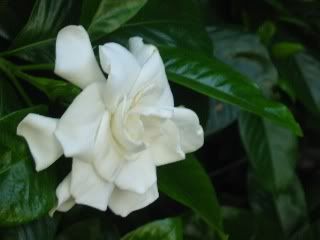.jpg) While Tuberose Gardenia went for a remarkably alive white floral with gardenia unfurling its waxy petals in front of your very eyes and Amber Ylang Ylang enhanced the familiar amber's unguent with soft lappings of powdery sexiness, Jasmine White Moss goes for the kill and proposes a nouveau chypre. Much maligned as a term that last bit might be however, the resurgence of the august family of chypre fragrances is a market fact: The mossy earthy bases (focused on vetiver & patchouli, often along with synthetic Evernyl, cedar and treemoss) in several fragrances launched in the last few years prove its durability as a genre, even in altered states. Estée Lauder herself seemed deeply enchanted with the abstract harmonies of the typical chypre formula, supervising several in her lifetime: Azurée (1969), Alliage ~also spelled Aliage for the US market~ (1972), Private Collection (1973) and Knowing (1988).
While Tuberose Gardenia went for a remarkably alive white floral with gardenia unfurling its waxy petals in front of your very eyes and Amber Ylang Ylang enhanced the familiar amber's unguent with soft lappings of powdery sexiness, Jasmine White Moss goes for the kill and proposes a nouveau chypre. Much maligned as a term that last bit might be however, the resurgence of the august family of chypre fragrances is a market fact: The mossy earthy bases (focused on vetiver & patchouli, often along with synthetic Evernyl, cedar and treemoss) in several fragrances launched in the last few years prove its durability as a genre, even in altered states. Estée Lauder herself seemed deeply enchanted with the abstract harmonies of the typical chypre formula, supervising several in her lifetime: Azurée (1969), Alliage ~also spelled Aliage for the US market~ (1972), Private Collection (1973) and Knowing (1988).Now comes Jasmine White Moss: Inspired by the spirit of Estée (née Josephine Esther Mentzer) and categorized as a floral, green chypre, being the closest of the trio in terms of fragrance family ties to the original Private Collection. Aerin Lauder, supervisor of the new scent and depicted in a white jersey vintage Halston dress with a white flower in her hair in the print ads says:
“…there is a lot of Estée in this project. We chose the blue stone accents [of white jade, dark and light lapis, sodalite, black agate, mother-of-pearl and blue lace agate] because blue was her favorite color; a basket weave design on the cap, since that was one of her favorite textures; her signature is on the lower right side of the bottle, and of course the juice began as her project.”According to official press: "Private Collection Jasmine White Moss began as Formula #546AQ— conceived by Estée alongside the International Flavors and Fragrances (IFF) team in June 1989. Never completed in her lifetime, it remained untouched in the IFF archives for decades, until Aerin decided to revisit the juice a year and a half ago". (source)
First of all it is refreshing to see that in an age when divulging has become synonymous with the ad serviendum demand of the buying public the Lauder team admits that all those Estée Lauder scents, which have made fortunes and have catapulted the American perfumery tradition like no other, have been harboured by labourers of the prestigious IFF company and not by Estée herself as was the myth for years (Despite that, it is undoubted that she had a discerning and tasteful veto on the creations herself; after all she ranks among the 20 most influential business geniuses of the 20th century). Indeed American perfumer Josephine Catapano, working with Ernest Shiftan, is the true creator of the mythical and trend-setting oriental Youth Dew (her other well-known creations include Fidji for Laroche and Norell's Norell, later sold to Revlon); she also paved the way for Belarussian by birth Sophia Grojsman who in turn composed several Lauder fragrances to great aplomb (White Linen, Beautiful, Spellbound)!
While Tuberose Gardenia was composed by Firmenich's Harry Fremont, the baton is taken again by IFF for Jasmine White Moss injecting the fragrance with a new material of which they are having the exclusive rights: "white moss mist". The ingredient is quite elegant and provides much of the success of the soft and refreshingly mossy composition. Let me mention in passing that White Moss is also the name of a 1997 Acca Kappa fragrance (Muschio Bianco, although muschio means musk in reality) as well as a L'erbolario fragrance by the same name. The "white moss" ingredient has been fearured in I am King by Sean John (another IFF fragrance) while IFF perfumers have also added it to Estée Lauder’s new Michael Kors limited-edition scent ~Island Capri (source). It is intriguing to contemplate that in this frame there is a hybrid of the Rosa Damascena family called Quatre Saisons Blanc Mousseux, which is known in English as 'Perpetual White Moss' or 'Rosier de Thionville'. Its inclusion seems plausible, especially given the background that reminds me of Chanel No.19 with its powdery rosy greenness, delicate petals amidst the emerald plush, and IFF's headspace technology.
Azurée and the original Private Collection provide the consanguinity. Yet while I had included the original Azurée (NB this is NOT the recent beachy Azurée Soleil) to my Big Bruisers article, as part of my Leather Series, and while Private Collection can be said to be another handsome powerhouse of strident proportions, Jasmine White Moss proves easier to wear than both even with a distinct late 60s-early 70s vibe. However her dainty foot is firmly placed in the modern Jimmy Choo peep-toe of a fiercely smart secretary rather than the classic Roger Vivier pump of the coiffed boss. The opening is nicely old-fashioned, perfumey, comprised of a non-indolic jasmine which oscilates between freshness and tonic dryness. Concerns about regulations to the use of jasmine or moss shouldn't concern: the wizardry at IFF suggests everything is possible with judicious use of small amounts of naturals alongside man-made essences. Its aura of mossy depth appears at once luxurious and reserved. Jasmine White Moss is soft without appearing meek, elegant without pretence and would be the perfect introduction to even wilder, bitter arpeggios for those willing to take the plunge. The gratification from the latter course would be even greater!
 Notes for Private Collection Jasmine White Moss by Estée Lauder:
Notes for Private Collection Jasmine White Moss by Estée Lauder: Top: mandarin, black currant bud absolute, galbanum and bergamot
Heart: jasmin sambac absolute (Aerin’s choice), jasmin India absolute (Estée’s choice), violet, orange flower absolute, orris and ylang-ylang
Bottom: patchouli heart absolute, vetiver and white moss mist (the latter is an ingredient exclusive to Lauder.)
Lauder's Private Collection White Moss is available as 30 and 75ml of Eau de Parfum, as 30ml extrait de parfum and as a solid in pendant. It will be featured in 260 U.S. specialty doors in July, including Saks Fifth Avenue, Neiman Marcus, Bloomingdale’s, Nordstrom and Bergdorf Goodman. Internationally, the scent will launch at Harrod’s in August. Testers have already appeared at Saks Fifth Avenue and Nordstorms for those willing to test it.
Related reading on Perfume Shrine: Jasmine Series, Chypres Series, Lauder reviews & news.
Photography by Guy Bourdin via Life Lounge
.jpg)







